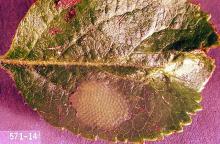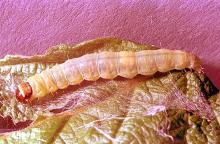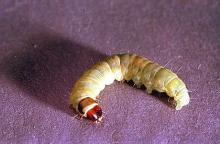Obliquebanded leafroller (Choristoneura rosaceana)
Pandemis leafroller (Pandemis pyrusana)
Pest description and crop damage These are similar to fruittree leafroller, but they overwinter as larvae and produce two generations each year. Pandemis leafroller larvae are green with a green or brown head and are about one inch long when fully grown. Adults are buff-colored moths with dark tan bands on the wings. They can be monitored with pheromone traps. Obliquebanded leafroller (OBLR) larvae are similar to pandemis larvae, except the head is dark brown to black. Larvae feed on leaves and enter cherry fruit, contaminating fruit. OBLR is the dominant leafroller pest in The Dalles and Milton-Freewater, OR.
Biology and life history Second generation leafrollers overwinter as immature larvae under the bark on scaffold branches of a variety of host plants including many native species. Larvae may feed during warm periods in winter but become active in spring with onset of new growth. They feed for several weeks, then pupate in rolled leaves. Adult moths emerge in late April to May. These lay eggs for the second generation. The second generation hatches in early summer during cherry harvest. Larvae can feed in cherries creating small holes or enter through rain induced cracks.
Pest monitoring Observe early spring growth for rolled leaves and feeding damage on new growth.
Management-biological control
Very low temperatures in winter significantly reduce overwintering populations of larvae. Spiders and parasitic wasps as well as predators like the brown lacewing greatly reduce leafroller populations throughout the year.
Management-chemical control: HOME USE
Warning: Many pesticides are hazardous to bees. Look for bee precautionary statements on product labels and do not use these products during bloom or if bees are foraging in the orchard.
Apply from April to May
- azadirachtin (neem oil)-Some formulations are OMRI-listed for organic use.
- Bacillus thuringiensis var. kurstaki-Some formulations are OMRI-listed for organic use.
- carbaryl-Highly toxic to bees.
- gamma-cyhalothrin-Highly toxic to bees.
- kaolin clay (Surround at Home)-Repels some insect pests when applied as a spray to leaves, stems, and fruit. OMRI-listed for organic use.
- lambda-cyhalothrin-Highly toxic to bees.
- malathion-Highly toxic to bees.
- plant-derived essential oils-Some have shown efficacy against leafrollers. Some formulations are OMRI-listed for organic use.
- pyrethrins-Some formulations are OMRI-listed for organic use. Highly toxic to bees.
- spinosad -Some formulations are OMRI-listed for organic use. Toxic to bees.
- zeta-cypermethrin-Highly toxic to bees.
Management-chemical control: COMMERCIAL USE
- Bacillus thuringiensis var. kurstaki (Dipel, Javelin, and others)-Check label for rates. REI 4 hr. PHI 0 days. Nontoxic to bees. This biologically derived material acts slowly: effectiveness requires good coverage. Apply when forecast calls for warm daily temperatures. This material is less effective during cool weather when larvae are not actively eating. Some formulations are OMRI-listed for organic use.
- chlorantraniliprole (Altacor 35WDG) at 3 to 4.5 oz/A. REI 4 hr. PHI 10 days. Do not apply more than 9 oz/A per season.
- lambda-cyhalothrin (Warrior II) at 1.28 to 2.56 fl oz/A. REI 24 hr. PHI 14 days. May disrupt beneficial mite populations. Extremely toxic to fish; avoid spray drift and surface runoff.
- methoxyfenozide (Intrepid 2F) at 0.12 to 0.25 lb ai/A (8 to 16 fl oz/A). REI 4 hr. PHI 7 days. Additional applications at 10- to 18-day intervals at maximum rates may be required for heavy infestations, sustained moth flight, situations in which it is difficult to achieve thorough coverage, and for quicker knockdown of larvae. See label for biofix information. Do not apply within 25 ft of an aquatic habitat, 150 ft if applied by air.
- spinetoram (Delegate WG) at 4.5 to 7 oz/A. REI 4 hr. PHI 7 days. Maximum of four applications of spinetoram per season. Do not apply more than a total of 28 oz of Delegate WG (0.438 lb ai spinetoram) per acre per year.
- spinosad (Entrust SC) at 0.06 to 0.12 lb ai/A (4 to 8 fl oz/A). REI 4 hr. PHI 7 days. Results are best when applied at petal fall. OMRI-listed for organic use. May act slowly. Do not exceed 0.45 lb ai/A spinosad (29 fl oz/A) per year.
Resistance management Pandemis leafrollers and obliquebanded leafrollers can develop resistance rapidly to chemical controls.





